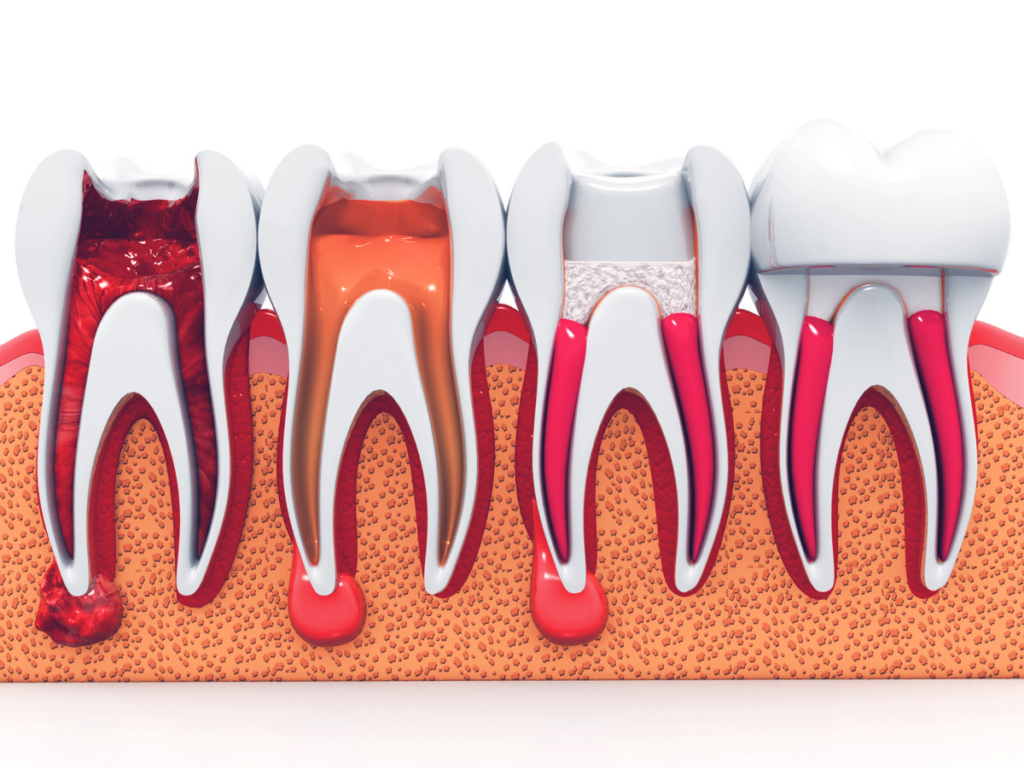There is still a way to save a heavily damaged tooth.
One of the last treatments that can save a heavily-damaged tooth is a root canal treatment, where dentists remove the pulp and nerve from inside the tooth and seal it to prevent further infection and abscess formation.
Depending on the extent of damage, a root canal treatment may take two visits. Your dentist will inform you about the process and any possible side effects before you proceed.
Here’s what you need to know about root canals.
What is a Root Canal?
Deep decay, repeated dental procedures, large fillings, facial trauma, or a crack or chip in a tooth can cause the nerve and pulp to become inflamed and infected. Leaving them untreated can lead to the infection of tooth tissue and abscess formation.
One of the few ways to save a severely infected or decayed tooth from extraction is a root canal procedure. Dentists remove the tooth pulp and nerve to prevent further infection while saving your natural teeth.
A tooth’s health or function is not affected by its nerves, especially if it has already erupted from the gums. Its sole function is to provide the sensation of heat or cold; its absence won’t affect your tooth’s functions.

Root Canal Treatment Procedure
Root canal treatments are not something to be nervous about. Your dentist will guide you through the process and make sure you’ll feel as little pain as possible.
Here are the steps of a root canal procedure you need to know.
Administration of the Anesthesia
The common misconception about a root canal treatment being painful is false. However, this has led some patients to just have their teeth removed, missing out on the chance to keep their teeth intact.
The anesthetics dentists use helps prevent you from feeling any pain. They will first apply a numbing cream to your gums to make sure you don’t feel any discomfort. After that, they will administer local anesthesia. You will only feel a slight pinch that will subside when they inject it. Although you’ll be awake all the time, you will not be in any pain.
Removal of the Pulp
Your dentist will create a small opening in the tooth that has been affected by decay or infection to expose the pulp. They will use a set of canal files that will help them clean the tooth canal.
Antibiotics
Your dentist will apply a topical antibiotic to the area where they performed the root canal treatment after removing the pulp to prevent any infection or reinfection. They may also prescribe oral antibiotics to ensure your teeth heal properly.
Placement of a Temporary Filling
The dentist will place temporary fillings to seal the tooth so that saliva and food particles do not get into the canal.
Root Canal Treatment Side Effects
Side effects and risks are part of every procedure. However, this does not mean that you shouldn’t do it; you can avoid some of these side effects and complications. You can always go to the dentist if you experience discomfort and ask questions after your procedure.
Some of the potential risks that you should be aware of are:
- Sometimes, a dentist might not find all the roots. Not treating all of the roots may spread the infection until it reaches the bone.
- Some things may happen during the procedure. Dental instruments may damage the root or the canal itself, making it difficult to fill.
- The temporary filling should cover the entire root canal. The infection may spread if this fails.
These side effects may be distressing for some, but there is no need to be alarmed. You’ll be fine as long as you follow all your dentist’s instructions on proper brushing and taking the antibiotics they prescribed.

Root Canal Treatment Cost
Sometimes people are unsure whether they should get a root canal because they don’t know how much it can cost. Before deciding to get it, ask your dentist about it. Root canal treatment costs may vary depending on the severity of the damage and tooth type; molars usually cost more to treat than other teeth.
A root canal is also cheaper than tooth extractions because other procedures are needed to bridge the gap made from the extraction.
Benefits of a Root Canal
A root canal is beneficial because:
- It saves your natural teeth.
- You will have no problems chewing.
- It prevents the infection from spreading.
- Your jawbone will not be affected by degeneration.
- It improves your overall dental health.
Key Takeaway
A root canal is one of the few ways to save a severely damaged tooth. Dentists begin by administering anesthesia to prevent you from feeling any pain. Then, they drill a small opening into your teeth to clean the tooth canal and the nerve. They will then apply antibiotics to your tooth and seal it to prevent further infection.
Root canal treatments also have side effects, but they are avoidable. They are also not expensive. Contact Century Dental for more information about root canal treatments and other dental services.
Reference:
Dental Health and Root Canals | webmd.com






